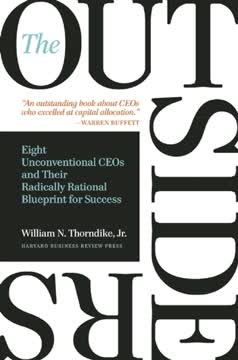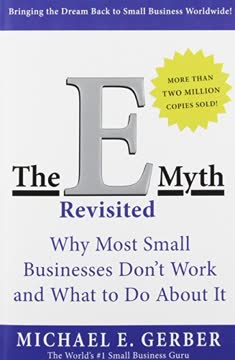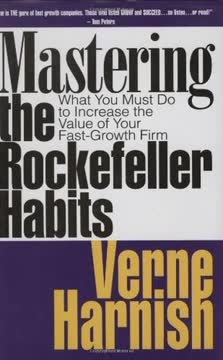النقاط الرئيسية
1. أولوية التنفيذ: التركيز على القيام بالأمور الصحيحة بشكل صحيح
"أنت لا تدير الأشخاص، بل تقودهم وتدير أنشطتهم."
إطار استراتيجي للأعمال. يقدم نموذج "الأمور الصحيحة بشكل صحيح" منهجًا شاملاً لإدارة الأعمال من خلال تحقيق التوازن بين الأشخاص والعمليات. يساعد هذا الإطار القادة على اتخاذ قرارات حاسمة بشأن الاتجاه الاستراتيجي للمؤسسة وتنفيذ العمليات التشغيلية.
المكونات الأساسية لنجاح الأعمال:
- الأشخاص المناسبون: توظيف وتطوير أفضل المواهب
- الأمور الصحيحة: تحديد الاتجاه الاستراتيجي واحتياجات العملاء
- القيام بالأمور بشكل صحيح: إنشاء عمليات وأنظمة فعالة
تحقيق توازن بين مصالح الأطراف المعنية. يؤكد النموذج على أهمية تلبية احتياجات العملاء والموظفين والمساهمين في آن واحد مع الحفاظ على كفاءة العمليات. يجب على القادة الموازنة المستمرة بين متطلبات الأطراف المختلفة وتحسين السمعة والإنتاجية.
2. إعداد خطة استراتيجية من صفحة واحدة للوضوح والتوافق
"يجب أن تتذكر أن هذه العملية تعتمد بنسبة 1% على الرؤية و99% على التوافق."
تبسيط استراتيجي. تحول خطة الاستراتيجية من صفحة واحدة التفكير الاستراتيجي المعقد إلى وثيقة واحدة قابلة للتنفيذ. من خلال تلخيص رؤية الشركة وأهدافها وأولوياتها في صفحة واحدة، يمكن للمؤسسات تحقيق تواصل واضح وتركيز عالٍ.
عناصر التخطيط الاستراتيجي:
- رؤية طويلة الأمد (10-25 سنة)
- الأولويات الفصلية والسنوية
- القيم الأساسية والهدف
- أهداف ومقاييس قابلة للقياس
- تحديد المسؤوليات
التوافق المتدرج. تتيح خطة الصفحة الواحدة للمؤسسات خلق سرد موحد من الأهداف الاستراتيجية العليا إلى أهداف الموظفين الفردية، مما يضمن فهم الجميع لدورهم في تحقيق نجاح الشركة.
3. تطوير القيم الأساسية لبناء ثقافة تنظيمية قوية
"ضع بعض القواعد، كررها كثيرًا، وتصرف باستمرار وفقًا لتلك القواعد."
الأساس الثقافي. تمثل القيم الأساسية المبادئ التوجيهية التي تشكل هوية المنظمة وقراراتها وسلوكها. توفر إطارًا ثابتًا للتوظيف وإدارة الأداء وتوجيه الاستراتيجية.
استراتيجيات تطبيق القيم الأساسية:
- استخدام السرد القصصي لتعزيز القيم
- دمج القيم في عمليات التوظيف والتأهيل
- مواءمة تقييمات الأداء مع القيم الأساسية
- الاحتفاء بالموظفين الذين يجسدون مبادئ المنظمة
الثبات الثقافي. من خلال التواصل المستمر والعيش وفقًا للقيم الأساسية، تخلق المؤسسات ثقافة قوية ومتجانسة تجذب أفضل المواهب وتحافظ عليها، وتوجه القرارات الاستراتيجية.
4. إتقان إيقاع الاجتماعات لتعزيز الأداء
"الروتين يحررك. إذا لم يكن لديك إيقاع للاجتماعات، فلن يكون لديك عمل."
هيكلة الاجتماعات الاستراتيجية. تطبيق إيقاع منظم للاجتماعات اليومية والأسبوعية والشهرية والربع سنوية يخلق توافقًا تنظيميًا، ومسؤولية، وتحسينًا مستمرًا.
مكونات إيقاع الاجتماعات:
- تجمعات يومية قصيرة من 5 إلى 15 دقيقة
- اجتماعات فريق أسبوعية
- جلسات تعلم وتوافق شهرية
- مراجعات استراتيجية ربع سنوية
- جلسات تخطيط سنوية
تسريع الأداء. تساعد الاجتماعات المنتظمة والمنظمة جيدًا المؤسسات على تحديد المشكلات وحلها بسرعة، والحفاظ على التركيز على الأولويات الرئيسية، واستثمار الذكاء الجماعي.
5. تحديد والسيطرة على نقطة الاختناق في السوق
"تحكم في نقطة الاختناق أو عنق الزجاجة في صناعتك لتحقق ميزة تنافسية."
التميّز الاستراتيجي. فهم والسيطرة على القيد الحاسم في صناعتك يمكّن الشركات من خلق عروض قيمة فريدة وميزات تنافسية مستدامة.
استراتيجيات تحديد نقطة الاختناق:
- تحليل سلاسل التوريد في الصناعة
- التعرف على قيود الموارد الحرجة
- استكشاف الحواجز التكنولوجية
- التعرف على تحديات التوزيع
التموضع التنافسي. من خلال معالجة القيد الأكبر في السوق بشكل استراتيجي، تستطيع الشركات خلق قيمة فريدة وتأسيس ريادة السوق.
6. جمع ملاحظات مستمرة من العملاء والموظفين
"المشاكل المتكررة تستهلك أكثر من 40% من وقت الموظف المتوسط."
عملية تحسين منهجية. يساعد تطبيق نظام ملاحظات منظم المؤسسات على التعرف المستمر على نقاط الضعف التشغيلية ومشاكل العملاء وحلها.
طرق جمع الملاحظات:
- تسجيل المشكلات أسبوعيًا
- استبيانات للعملاء والموظفين
- مراجعة منتظمة للمشاكل المتكررة
- فرق حل المشكلات متعددة الوظائف
التعلم التنظيمي. من خلال خلق ثقافة من الملاحظات المستمرة والتحسين، يمكن للشركات تعزيز الإنتاجية ورضا العملاء وانخراط الموظفين.
7. فهم وتحسين التدفق النقدي باستمرار
"النقد هو الأكسجين الذي يغذي النمو."
إدارة الأداء المالي. يتيح المراقبة المستمرة وتحسين دورة تحويل النقد للمؤسسات تمويل النمو من خلال النقد المتولد داخليًا وتقليل الاعتماد على التمويل الخارجي.
استراتيجيات تحسين التدفق النقدي:
- تتبع دورة تحويل النقد
- تحديد نقاط الاختناق في العمليات المالية
- تنفيذ مبادرات تحسين نقدية ربع سنوية
- تقليل الوقت بين الإنفاق واستلام الأموال
المرونة المالية. من خلال تطوير فهم عميق لديناميكيات التدفق النقدي، تستطيع الشركات بناء نماذج أعمال أكثر استدامة وقابلية للتكيف.
آخر تحديث::
FAQ
What's "Mastering the Rockefeller Habits" about?
- Focus on Growth: "Mastering the Rockefeller Habits" by Verne Harnish is a guide for business leaders on how to scale their companies effectively.
- Rockefeller Habits: The book introduces the Rockefeller Habits, a set of principles inspired by John D. Rockefeller's management practices.
- Practical Tools: It provides practical tools and strategies for managing growth, improving communication, and aligning teams.
- Target Audience: The book is aimed at CEOs and executives of mid-sized firms looking to grow their businesses sustainably.
Why should I read "Mastering the Rockefeller Habits"?
- Proven Strategies: The book offers proven strategies that have helped numerous companies achieve significant growth.
- Real-World Examples: It includes testimonials and case studies from successful business leaders who have implemented these habits.
- Actionable Advice: The book is filled with actionable advice that can be immediately applied to improve business operations.
- Comprehensive Framework: It provides a comprehensive framework for addressing common challenges faced by growing companies.
What are the key takeaways of "Mastering the Rockefeller Habits"?
- Priorities, Data, Rhythm: Focus on setting clear priorities, gathering relevant data, and establishing a rhythm of regular meetings.
- One-Page Strategic Plan: Use a concise strategic plan to align the organization and communicate goals effectively.
- Core Values: Define and live by core values to strengthen company culture and guide decision-making.
- Cash Flow Management: Improve cash flow through strategies like shortening cycle times and eliminating mistakes.
How does the One-Page Strategic Plan work in "Mastering the Rockefeller Habits"?
- Simplified Planning: The One-Page Strategic Plan condenses a company's vision, goals, and strategies into a single, easily digestible page.
- Alignment Tool: It serves as a tool for aligning the entire organization around key objectives and priorities.
- Regular Updates: The plan is meant to be updated regularly to reflect changes in the business environment and strategic direction.
- Focus on Execution: It emphasizes execution by breaking down long-term goals into actionable quarterly and annual priorities.
What is the significance of the Rockefeller Habits in the book?
- Historical Inspiration: The habits are inspired by John D. Rockefeller's management practices, known for their effectiveness in scaling businesses.
- Three Core Habits: The book focuses on three core habits: setting priorities, gathering data, and establishing a meeting rhythm.
- Foundation for Growth: These habits provide a foundation for sustainable growth by improving communication and accountability.
- Widely Adopted: Many successful companies have adopted these habits to drive performance and achieve their growth objectives.
How does "Mastering the Rockefeller Habits" address cash flow management?
- Cash Conversion Cycle: The book emphasizes the importance of understanding and improving the cash conversion cycle (CCC).
- Practical Strategies: It offers practical strategies for accelerating cash flow, such as billing more frequently and improving collections.
- Business Model Adjustments: Encourages businesses to adjust their models to improve cash flow, like getting customers to pay in advance.
- Daily Cash Reports: Recommends daily cash reports to keep cash flow top-of-mind and allow for quick adjustments.
What role do core values play in "Mastering the Rockefeller Habits"?
- Cultural Foundation: Core values serve as the cultural foundation of a company, guiding behavior and decision-making.
- Recruitment and Retention: They are used in recruitment and retention to ensure alignment between employees and the company.
- Daily Reinforcement: The book suggests ways to reinforce core values daily, such as storytelling and recognition programs.
- Alignment and Consistency: Core values help maintain alignment and consistency across the organization, especially during growth.
How does "Mastering the Rockefeller Habits" suggest handling meetings?
- Structured Meetings: The book advocates for structured daily, weekly, monthly, and quarterly meetings to maintain alignment and focus.
- Short and Focused: Meetings should be short and focused, with specific agendas to maximize efficiency and effectiveness.
- Daily Huddles: Daily huddles are recommended to quickly address issues and keep everyone informed and aligned.
- Peer Pressure and Accountability: Regular meetings create peer pressure and accountability, driving performance and execution.
What are some of the best quotes from "Mastering the Rockefeller Habits" and what do they mean?
- "Routine sets you free." This quote emphasizes the importance of establishing regular routines and rhythms to create freedom and efficiency in business operations.
- "If you want to teach people a new way of thinking, don’t bother trying to teach them. Instead, give them a tool." This highlights the book's focus on providing practical tools that lead to new ways of thinking and operating.
- "The key is not what core values an organization has but that it has core values at all." This underscores the importance of having core values to guide the organization, regardless of what they specifically are.
- "You don’t have a real strategy if it doesn’t pass these two tests: that what you’re planning to do really matters to your existing and potential customers; and second, it differentiates you from your competition." This quote stresses the need for a strategy that is both customer-focused and differentiating.
How does "Mastering the Rockefeller Habits" help with setting priorities?
- Top 5 and Top 1 of 5: The book introduces the concept of setting a Top 5 and a Top 1 of 5 priorities to maintain focus.
- Alignment Across Organization: It emphasizes the need for alignment across the organization, with each team and individual setting their own aligned priorities.
- Management Accountability Plan: Provides a framework for assigning accountability and tracking progress on priorities.
- Focus on Execution: Encourages focusing on execution by breaking down priorities into actionable steps and regularly reviewing progress.
How does "Mastering the Rockefeller Habits" suggest improving customer and employee feedback?
- De-Hassling System: The book recommends creating a system to gather and address recurring customer and employee hassles.
- Start/Stop/Keep Questions: Suggests using start/stop/keep questions to gather feedback and identify areas for improvement.
- Regular Feedback Loops: Emphasizes the importance of regular feedback loops to continuously improve products, services, and processes.
- Leadership Development: Encourages using feedback systems as a leadership development opportunity for mid-level managers.
What is the role of the Brand Promise in "Mastering the Rockefeller Habits"?
- Differentiation: The Brand Promise is a key differentiator that sets a company apart from its competitors.
- Customer Focus: It focuses on what really matters to customers and aligns with their needs and expectations.
- Measurable Deliverable: The Brand Promise should be a measurable deliverable that drives all strategic and tactical decisions.
- Evolving Over Time: The book acknowledges that a Brand Promise may need to evolve over time as market conditions and customer needs change.
مراجعات
يحظى كتاب "إتقان عادات روكفلر" بتقييمات إيجابية إلى حد كبير، حيث يشيد القراء بنصائحه العملية التي تساعد في نمو الأعمال التجارية. يجد الكثيرون تركيز الكتاب على الأولويات، والبيانات، وإيقاعات الاجتماعات مفيدًا للغاية. ويشير بعضهم إلى أن محتواه يناسب الشركات القائمة أكثر من الشركات الناشئة. كما يثمن القراء التأكيد على وضع أهداف واضحة والتميّز عن المنافسين. أما النقاد فيلفتون إلى بعض المراجع القديمة وأحيانًا كثافة المحتوى. وبشكل عام، يُعتبر الكتاب مصدرًا قيّمًا لقادة الأعمال الذين يسعون إلى استراتيجيات نمو منظمة ومدروسة.
Similar Books















